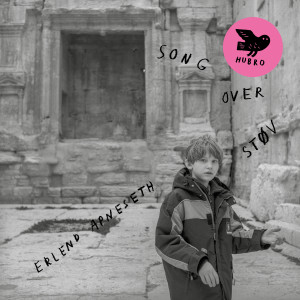 This album is a deep, complex and engaging exploration of the borderlands where Norwegian traditional music meets chamber folk, art song, and avant garde minimalism. We’re in good hands with Hardanger fiddler and composer Erlend Apneseth at the helm.
This album is a deep, complex and engaging exploration of the borderlands where Norwegian traditional music meets chamber folk, art song, and avant garde minimalism. We’re in good hands with Hardanger fiddler and composer Erlend Apneseth at the helm.
The last recording under Apneseth’s name that I reviewed was his 2022 solo Hardanger outing Nova, which stands in stark contrast to Song Over Støv. On this new album he employs a large ensemble including some of the top Nordic musicians: Frode Haltli on accordion, Rolf-Erik Nystrøm (who among his many credits has played on some of my favorite albums by the Nils Økland Band and Benedicte Maurseth) on saxophones; the inimitable Mats Eilertsen on double bass; Hans Hulbækmo and Veslemøy Narvesen on drums and percussion; the progressive flutist Henriette Eilertsen, and Anja Lauvdal on keyboards, synths and harmonium.
Now, as I quoted Erlend in my review of Nova, “The Hardanger fiddle is traditionally a soloistic instrument. For me, one of the most fascinating things about the instrument is its ability to fill a whole room with sound all by itself.” On the other hand, this time around he notes that “Fiddles tend to get a bit drowned out in larger ensembles … “, so what did he do but enlist three other Hardanger fiddlers. They are Selma French Bolstad, Helga Myhr, and Rasmus Kjorstad (three-fifths of the great Norwegian avant-folk band Morgonrode, with whose recent output I definitely to catch up). All of them also contribute their voices to some of the songs on this album, and Kjorstad also plays an octave fiddle and a just regular plain old fiddle fiddle.
“With a quartet of Hardanger fiddles in the band, I’ve also felt more comfortable including more specific elements from tradition than before —like ornamentation and various springar rhythms— because I know they’ll come through clearly,” Erlend says.
If it’s deeper into tradition, it’s also quite deep into more modern elements, as you might expect from that list of highly innovative and creative musicians who play with Erlend this time — and the fact that the project originated as a commissioned work for Oslo World and Riksscenen and was informed by his participation in Haltli’s Avant Folk project over the past few years.
So what do we have here? The main takeaway is, this is a big band, and you’re nearly always conscious of that. To me, the heart of the record is in … the heart of the record, tracks 3 and 4 out of the 6. Track 3 is “Song Over Støv (dust),” an Anatolian flavored tune played in unison on (just guessing here) saxophone, octave fiddle and at least one Hardanger, bowed bass and perhaps more, after a dramatic introduction of booming drums and clattering percussion. Eventually the entire ensemble joins in, most prominently accordion but also harmonium and synthesizer, a wild and chaotic, part composed part improvised melange. It segues into a dramatic chamber piece that drops out leaving voices singing a lovely, comforting wordless version of the dominant melody. To me, this would be utterly fascinating and almost unbearably moving in live performance!
It’s followed by “Spring,” a galumbering (my portmanteau of galloping and lumbering) springar with keyboard and horn drones, with thudding drums and clapping percussion driving the ensemble playing. Improvised sections, prominently featuring Henriette’s flute, build to and through a cacophony, slowly returning to that original dance tune, which emphasizes the springar’s uneven four-beat rhythm.
The rest of the program is variations on those themes, with plenty of unison playing both among the fiddles and drawing in other instruments as well. The opening tune “Straumen Forbi (The Current Passing By) takes a little over 7 minutes to introduce the album’e ethos, a conscious melding of deep traditional music and avant garde ideas: A lengthy section of unison fiddling (and blowing) on an obviously folk inspired melody, bookended by brief sections of freeform plucked strings and struck percussion. “I Natt” (Tonight), is a short, programmatic improvised piece of Apneseth and Rasmus Kjorstad plucking and bowing, accompanied by the flute with subtle contributions from saxophone and bass. After “Trø” (Step), a minimalist bedehus hymn comes the closing piece “Samdrøm” (Shared Dream), another long song with lots of Hardanger and harmonium in a pure demonstration of the essence of Norwegian traditional music, which then morphs through some keyboard and synth minimalism, before flute, fiddles and voices ease their way back into the sonic tapestry for the dreamy conclusion.
“I really enjoy unison playing and allowing things to repeat over time, which might stem from my own background,” Erlend says. The effect of unison playing is even more pronounced when it involves the overtone-rich Hardanger. Highly recommended for anyone who enjoys lots of fiddles and a seriously joyful session of music making that’s free of boundaries and preconceptions.
(Hubro, 2025)
